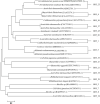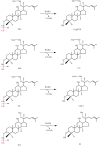Cloning and characterization of thermophilic endoglucanase and its application in the transformation of ginsenosides
- PMID: 36307574
- PMCID: PMC9617004
- DOI: 10.1186/s13568-022-01473-z
Cloning and characterization of thermophilic endoglucanase and its application in the transformation of ginsenosides
Abstract
A novel endoglucanase (BcelFp) was identified from Fervidobaterium pennivorans DSM9078 which had biotransformation activity for protopanaxadiol (PPD)-type ginsenosides. Sequence analysis of BcelFp revealed that it could be classified into glycoside hydrolase family 5 (GH5). The gene encoding a 323-amino acid protein was cloned and expressed in Escherichia coli. The recombinant enzyme was purified, and its molecular weight was approximate 37 kDa. The recombinant BcelFp exhibited an optimal activity at 95 oC and pH 5.5 and showed high thermostability. The endoglucanase had high selectivity for cleaving the outer glucose moiety at the C3 carbon of ginsenoside Rb1, Rb2, Rc and Rd, which produced stronger pharmacologically active gypenoside XVII (GypXVII), Compound O (CO), Compound Mc1 (CMc1) and F2, respectively. The Km values for Rb1, Rb2, Rc and Rd were 3.66 ± 0.04 µM, 4.02 ± 0.12 µM, 5.95 ± 0.03 µM, 0.67 ± 0.006 µM, respectively. The kcat/Km value of BcelFp for ginsenoside Rd was 27.91 mM-1s-1, which was much higher than that of the previously enzymes. This study was the first report of the highly efficient and selective transformation of GypXVII, CO, CMc1 and F2 from Rb1, Rb2, Rc and Rd by a GH5-family thermophilic endoglucanase.
Keywords: Biotransformation; Endoglucanase; Fervidobaterium pennivorans DSM9078; Ginsenoside; Glycoside hydrolase family.
© 2022. The Author(s).
Conflict of interest statement
The authors declare that they have no competing interests.
Figures






Similar articles
-
Preparation of minor ginsenosides C-Mc, C-Y, F2, and C-K from American ginseng PPD-ginsenoside using special ginsenosidase type-I from Aspergillus niger g.848.J Ginseng Res. 2015 Jul;39(3):221-9. doi: 10.1016/j.jgr.2014.12.003. Epub 2014 Dec 31. J Ginseng Res. 2015. PMID: 26199553 Free PMC article.
-
A GH1 β-glucosidase from the Fervidobacterium pennivorans DSM9078 showed extraordinary thermostability and distinctive ability in the efficient transformation of ginsenosides.Bioorg Chem. 2025 Jan;154:108049. doi: 10.1016/j.bioorg.2024.108049. Epub 2024 Dec 9. Bioorg Chem. 2025. PMID: 39667076
-
Characterization of a novel recombinant β-glucosidase from Sphingopyxis alaskensis that specifically hydrolyzes the outer glucose at the C-3 position in protopanaxadiol-type ginsenosides.J Biotechnol. 2014 Feb 20;172:30-7. doi: 10.1016/j.jbiotec.2013.11.026. Epub 2013 Dec 11. J Biotechnol. 2014. PMID: 24333127
-
Enzymatic Biotransformation of Ginsenoside Rb1 and Gypenoside XVII into Ginsenosides Rd and F2 by Recombinant β-glucosidase from Flavobacterium johnsoniae.J Ginseng Res. 2012 Oct;36(4):418-24. doi: 10.5142/jgr.2012.36.4.418. J Ginseng Res. 2012. PMID: 23717145 Free PMC article.
-
Identification and characterization of a novel Terrabacter ginsenosidimutans sp. nov. beta-glucosidase that transforms ginsenoside Rb1 into the rare gypenosides XVII and LXXV.Appl Environ Microbiol. 2010 Sep;76(17):5827-36. doi: 10.1128/AEM.00106-10. Epub 2010 Jul 9. Appl Environ Microbiol. 2010. PMID: 20622122 Free PMC article.
Cited by
-
Enhancing the Heterologous Expression of a Thermophilic Endoglucanase and Its Cost-Effective Production in Pichia pastoris Using Multiple Strategies.Int J Mol Sci. 2023 Oct 9;24(19):15017. doi: 10.3390/ijms241915017. Int J Mol Sci. 2023. PMID: 37834464 Free PMC article.
-
Production of Gypenoside XVII from Ginsenoside Rb1 by Enzymatic Transformation and Their Anti-Inflammatory Activity In Vitro and In Vivo.Molecules. 2023 Oct 9;28(19):7001. doi: 10.3390/molecules28197001. Molecules. 2023. PMID: 37836844 Free PMC article.
-
Transcriptome Profiling, Cloning, and Characterization of AnGlu04478, a Ginsenoside Hydrolyzing β-Glucosidase from Aspergillus niger NG1306.Curr Microbiol. 2024 Dec 24;82(1):56. doi: 10.1007/s00284-024-04012-0. Curr Microbiol. 2024. PMID: 39718650 Free PMC article.
-
Characterization of vitamin D3 biotransformation by the cell lysate of Actinomyces hyovaginalis CCASU-A11-2.AMB Express. 2024 Apr 24;14(1):43. doi: 10.1186/s13568-024-01694-4. AMB Express. 2024. PMID: 38658456 Free PMC article.
-
Biotransformation of Ginsenoside Rb1 to Ginsenoside Rd and 7 Rare Ginsenosides Using Irpex lacteus with HPLC-HRMS/MS Identification.ACS Omega. 2024 May 16;9(21):22744-22753. doi: 10.1021/acsomega.4c00837. eCollection 2024 May 28. ACS Omega. 2024. PMID: 38826525 Free PMC article.
References
-
- Cleland WW (1979) Statistical analysis of enzyme kinetic data. Methods Enzymol 63. 10.1002/9780470122747.ch1. :103 – 38 - PubMed
Grants and funding
LinkOut - more resources
Full Text Sources
Miscellaneous

